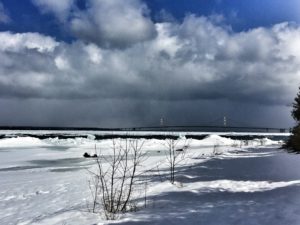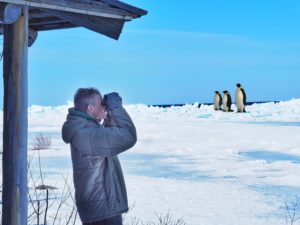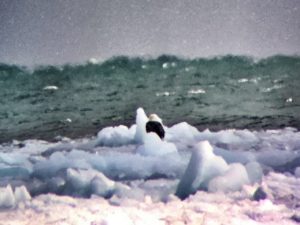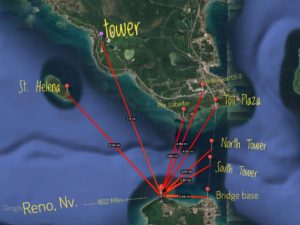
Weather –
-5.0 C with 45kph NW winds at 7:05 AM when I arrived. It took nearly half an hour just to get situated under the gazebo as my poncho tarp had a catastrophic failure ( a grommet snapped). I remembered I had my tent ground cloth with me and that was erected promptly as a windbreak. By the time I called the count at 13:00 it had warmed up to -3.3 but the winds had kicked up again after a brief lull while it snowed. For the most part visibility was good to the east and west, but the heat shimmer blowing in on the northwest wind made detections over a 1k difficult. The marine forecast for Mackinaw City called for 2 foot chop, but in the straits near the edge of the ice it looked like it was stacking up 4-5ft swells with whitewater rushing down the faces of the waves. Ice came to McGulpin Point from the north shore and the wall of blue ice to the NW of the point has grown to 10-15 ft high in spots.
Waterbird Notes –

The effort today was well worth it as there was one notable waterbird detection, a Common Loon. This was the first loon of the season I have spotted and it was a memorable sighting. The loon was a stand out by its style of non-stop flight from east to west through the straits, basically directly over the shipping channel ( but the loon is faster than a ship). The loon was maybe 5-10 ft off the surface of the waves and never varied elevation nor did it change direction once. When it was to the NW of McGulpin Point I could make out the long stretched out wings centered on the body, long head and feet trailing the bird. The feet weren’t visible, but more looked like a long tail. Based on the more grey appearance and washed out look it was noted as an adult non- breeding bird.
Even when a bird was spotted, getting a good look at the plumage through the distorted light was difficult. The heat shimmer was really bad, even close in. The best way to describe it is it seemed as if I couldn’t get the spotting scope in focus all day. Spotting birds on the surface in the chaos of wave action is difficult too. The waves on the straits aren’t organized like an ocean swell so a raft of birds could be hidden anywhere. Coupled with the heat waves this made for a slow day. Other than the COLO I spent most of the day trying to get a high count on RBME.
The ice wall to the NW of McGulpin Point grew today to between 10-15ft high. This wall of blue ice is in front of roughly 30% of my view of the lake horizon. I have noticed that there is a lot of waterbird activity over there currently. For low flying birds like merganser and LTDU, I am certainly missing them to the NW behind the wall of ice. The horizon over there is larger too, so that there is even a cumulative loss of visibility in that direction versus the north shore being hidden behind ice which I can see land behind. This is not to be registered as a complaint, other than I wanted to note that this is impacting the daily tally for the time being.

Non- waterbird Notes –
Very quiet in the forest behind the gazebo today. That kind of makes sense as the shoreline was brutal. Why not take cover in the windbreak of the forest if your a small passerine? No MODO to greet me when I opened the car door today!
The Bald Eagle were back out in force making use of the floating rafts of ice. For now the eagles are most active right at dawn. There were 4 distinct individuals out there this morning. An adult bird whom I consider to be the resident at McGulpin, a S1 bird and 2 x S2 birds. The 2 S2 birds put on a really good show even if they weren’t successful in parachuting down to whatever they were attempting to snatch. The interesting thing to me about this observation is the two birds were clearly flying along the shoreline towards the gazebo from the east only meters apart. One would parachute down and attempt to grab something I could never make out in the water. When the one was unsuccessful the other one would take a turn. It should also be noted of the two birds, one was significantly smaller than the other. The disparity in size almost made it seem as if a Red- tailed Hawk was flying with an eagle. This may sound like an exaggeration, but that is how it seemed when comparing the size of each bird. These birds where clearly together as there was no squabbling or attempt to displace each other. That is the first two Bald Eagles of the count I have seen being cooperative or non- confrontational to each other.
Here is a slick satellite map Steve Baker made for me with the distances to different landmarks from McGulpin Point. This is going to be used regularly now as a way to estimate distances for visibility. I included it in today’s post as I believe it gives a good visual of where the waterbird count is taking place.

Freighters –
Edwin H. Gott eastbound at 12:55 and Niagara at 9:45.
Visitors –
None. The new snow on top of the ice is actually better for traction so the road down isn’t too bad. 45Kph gust with -5.0 temps are bad.
Total observer hours – 5.5
Next days forecast –
Mostly sunny, with a high near 33. West wind 10 to 15 mph.
Daily total is posted on eBird here.
